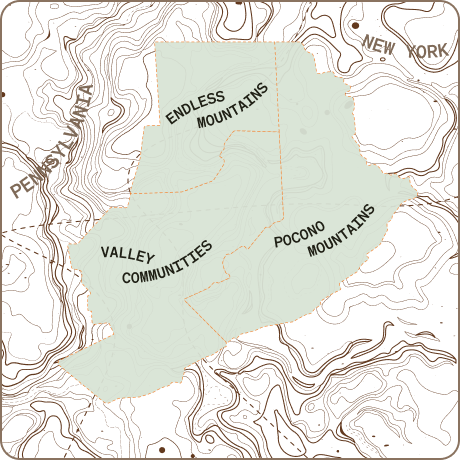DiscoverNEPA is partnering with North Branch Land Trust, a nonprofit that conserves the natural, working and scenic landscapes of NEPA. They’ll provide conservation tips and give us a look at their protected lands. Learn how you can join NBLT and do your part to protect NEPA’s natural resources.
This Time of Year, Hikes Can Start Looking a Little Monochrome.
Until there is a consistent coating of snow sparkling, lost leaves and bare branches can make hibernation seem quite tempting. If your walks start to feel more ennui than energizing, it might be time to add some color with evergreen habitats!
Throughout spring, summer, and fall, one can visit any public natural area in Northeastern Pennsylvania and be surrounded by luscious color. But how do you find a verdant oasis amidst the snow and ice? In early winter, being choosy with your trail can still lead you to gorgeous green growth.

What’s an Evergreen?
Like their name implies, evergreens remain “ever green” even when winter chill sets in. This close to the holidays, you are probably never more than a few feet away from a pine, fir, hemlock, or holly. Other local evergreens include some laurels, rhododendrons, ivies, and junipers. These species have special adaptations that help them to curb water loss and thrive in low-nutrient environments. Beneath snow and ice, these plants eschew drab dormancy to provide pops of color until spring.
Where Do Evergreens Grow in NEPA?
Because evergreens can thrive in habitats where other plants struggle, it is not uncommon for them to grow together. Ridgetop acidic barrens, analogous to the famed New Jersey Pine Barrens and, more locally, the Crystal Lake Tract of Pinchot State Forest, can offer unique pitch pines and laurels in addition to stunning views. Eastern hemlocks can be found in many NEPA forests and rocky outcrops, but if you are searching for a full grove, consider areas that are shady and moist. In Northeastern Pennsylvania’s natural areas, white pines are hardy adapters, and they can live as long as 200 years. Therefore, it can be easy to find incredible specimens thriving along roadsides as well as deep in the untouched wilds.
Planning Your Evergreen Hike
Evergreen hikes require a little more advanced planning than your average early fall foray. If you are unsure of where evergreens may be hiding along your favorite trails, be sure to reach out to staff at our beautiful public lands or other property representative for their tips—North Branch Land Trust recommends visiting the scenic Butler Preserve Pine Barrens or enjoying the diversity of trees at Forest Echo Bird Sanctuary. This time of year, it can be even more important to be aware of your surroundings. Be cautious of changing weather conditions and dress appropriately in layers that can be added and removed with ease. Exercise additional caution by wearing stand-out colors like blaze orange (which may be legally required on certain lands). Finally, be aware of how weather can affect the evergreens themselves. Without leaf-loss, evergreen branches can hold a lot more snow than their bare cousins and can bend, snap, or dump snow on those unaware.

North Branch Land Trust conserves lands, waters, and vistas in an eight-county region of Pennsylvania (Bradford, Susquehanna, Sullivan, Wayne, Wyoming, Lackawanna, Luzerne, and Columbia) in the Upper Lehigh and Susquehanna North Branch Watersheds. To learn more about supporting their conservation work in Northeastern Pennsylvania, visit nblt.org.
Featured Image (top) Hikers traverse a Bear Creek evergreen grove. Photo courtesy of North Branch Land Trust.


















